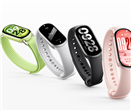

Time:2025-04-08
Driven by the wave of digital health, wearable devices are upgrading from single functional products to full scenario health management tools. After smart speakers and smartwatches,Smart RingWith its advantages of seamless wearing, precise monitoring, and all-weather protection, it has become a new focus in the field of health technology.
The core functions of smart rings
24/7 health monitoring
Compared with traditional wearable devices, smart rings are designed to be lighter and more in line with the human body, achieving better understanding of users' physiological dataContinuous dynamic trackingFor example:
Basic vital sign monitoringReal time collection of heart rate, blood oxygen saturation, body temperature and other data, with an accuracy rate of over 90%, second only to medical grade equipment level;
Deep Health AnalysisBy using AI algorithms to analyze sleep quality (such as deep sleep duration, REM cycle), stress index, blood glucose fluctuation trend, etc., personalized health reports are provided to users;
Active warning functionAbnormal data (such as sudden arrhythmia, low blood oxygen) triggers immediate alerts, links emergency contacts, and reduces health risks.
Behind this series of functions isCollaborative ecosystem of software and hardwareThe support. On the hardware side, the ring is equipped with high-precision sensors and low-power chips; On the software side, cloud data analysis and mobile app form a closed loop to generate executable health recommendations for users.
intelligenceWearing(intelligenceThe ring is regarded as an advanced electronic medicine abroad. Combined with telemedicine technology, it can:
chronic disease management: Provide blood glucose fluctuation trend prediction for diabetes patients, and assist in adjusting medication plans;
Remote diagnosis and treatment supportDoctors can view patient data in real-time, especially suitable for areas with scarce medical resources;
Postoperative rehabilitation monitoringTrack the recovery of postoperative patients' physical signs and reduce the frequency of follow-up visits.
Data driven health management
The long-term health data accumulated by the smart ring can help users establish personal health baselines and identify potential disease risks in advance, such as sleep apnea syndrome and cardiovascular abnormalities.
User Privacy and Security
Adopting end-to-end encryption technology to ensure the security of sensitive medical data during transmission and storage, in compliance with the regulatory requirements of the healthcare industry.
market prospect
According to research institutions' predictions, the global smart ring market size will exceed billions of dollars by 2025, mainly driven by an aging society, a younger population with chronic diseases, and an upgrade in consumer health awareness.
Future smart rings will no longer be limited to a single hardware, but will be deeply integratedDigital Health Ecology:
Cross device linkageIntegrate and analyze environmental health parameters (such as indoor air quality) and personal physical sign data through interoperability with smart home and in car systems;
Integration of Insurance and Health ServicesCollaborate with commercial insurance to customize premium plans based on user health data;
AI Health AssistantThrough natural language interaction, provide comprehensive guidance on diet, exercise, medication reminders, and more.






Tel
Mobile phone
Customer service
TOP